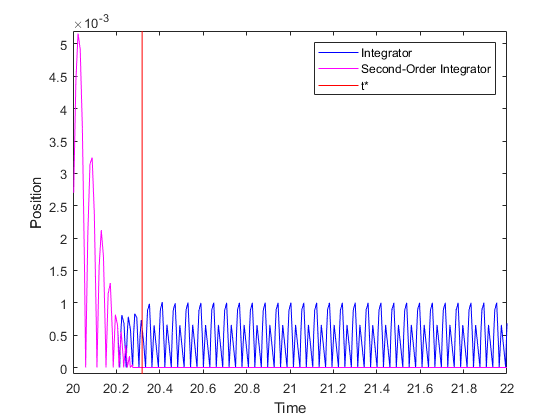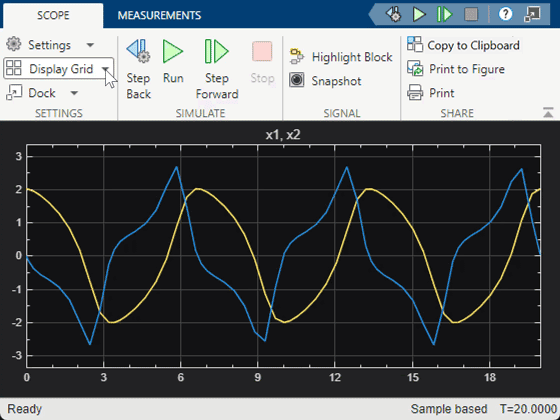Floating Scope 和波形查看器
显示仿真过程中生成的信号,无信号线
库:
Simulink /
Sinks
HDL Coder /
Sinks
描述
Simulink® 波形查看器和 Floating Scope 模块基于仿真时间显示时域信号。波形查看器和 Floating Scope 模块的功能与 Scope 模块相同,但它们不连接信号线。
“示波器”选项卡
此屏幕截图突出显示示波器窗口的重要方面。
示波器画面支持:
仿真控制 - 从“范围”窗口中使用运行、步进和步退工具栏按钮可以运行和调试模型。
多个信号 - 在同一显示画面上绘制多个信号。
多个显示画面 - 在多个子图上显示信号。子图的所有 y 轴在 x 轴上具有共同的时间范围。使用工具条的示波器选项卡中的显示网格参数控制子图的布局。
修改参数 - 在仿真之前和仿真期间修改波形参数值。
自动缩放轴范围 - 在仿真期间或仿真结束时自动缩放轴范围。在坐标区的顶部和底部会留有边距。
仿真后显示数据 - 仿真期间保存波形数据。如果在仿真开始时波形视图关闭,则当您在仿真后打开波形视图时,波形视图将显示附加的输入信号的仿真结果。
注意
如果采样率高或仿真时间长,可能会遇到内存或系统性能问题,因为示波器在内部保存数据。要限制为波形可视化保存的数据量,请使用
Limit data points to last属性。示波器窗口管理 - 使用新示波器容器将多个示波器窗口停靠到单个窗口中,并管理和组织示波器。示波器容器还使您能够在单个窗口中查看模型中的所有示波器。
“测量”选项卡
此屏幕截图突出显示测量窗口的重要方面。
以下是波形查看器和 Floating Scope 模块支持的所有测量列表:
您必须拥有 Simscape 或 DSP System Toolbox 许可证,才能使用峰值查找器、双电平测量和信号统计这些功能面板。
有关从命令行控制 Floating Scope 模块的信息,请参阅以编程方式控制 Scope 模块。
连接信号
在 Floating Scope 窗口或波形查看器窗口中,使用 ![]() 按钮连接信号。
按钮连接信号。
要添加具有连接信号的查看器,请在模型中选择一个信号。然后,在仿真选项卡的准备库中,点击添加查看器。
有关详细信息,请参阅将信号添加到现有浮动示波器或波形查看器。
主要功能
多个 y 轴(显示画面)- 显示多个 y 轴。所有 y 轴在 x 轴上具有共同的时间范围。
多个信号 - 在同一 y 轴(显示画面)上显示多个信号。
修改参数 - 在仿真之前和仿真期间修改波形参数值。
在仿真后显示数据 - 如果在仿真开始时关闭了示波器,仿真期间波形数据依然会写入波形视图。如果您在仿真后打开该示波器,波形视图将显示输入信号的仿真结果。
示例
限制
当您使用优化仿真的模型配置参数(例如信号存储重用或模块简化)时,Simulink 会在仿真期间消除某些信号的存储。您无法将 Floating Scope 应用于这些消除的信号。要解决此问题,请将消除的信号配置为测试点。随后可以将 Floating Scope 应用于信号,不管优化设置如何。要配置测试点,请参阅将信号配置为测试点。
如果您在添加或删除信号后步退仿真,Floating Scope 将清除现有数据。直到仿真再次步进后才会出现新数据。
在连接到常量信号时,示波器绘制单个点。
Floating Scope 模块和波形查看器不支持 Simulink 消息。
您不能连接来自 For Each 子系统的信号。
示波器显示画面在快速加速模式下有限制。请参阅 示波器和查看器在快速加速模式下的行为。
端口
输入
属性
模块特性
数据类型 |
|
直接馈通 |
|
多维信号 |
|
可变大小信号 |
|
过零检测 |
|







